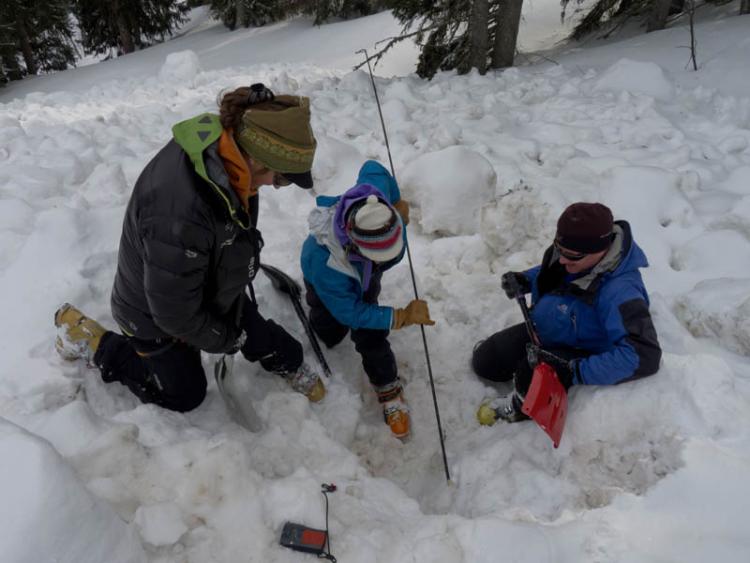More than 90% of avalanches are triggered by the victim(s) and 95% of survivors are rescued by their companions. Practicing companion search and rescue is vital. This page describes the key elements, from having the right equipment to first aid.
Equipment – Transceivers
The most important thing with any avalanche transceiver is to make sure you get lots of practice using your own device. However, transceiver technology has advanced a great deal over the last 10 years or so, and if you have an older model, it is well worth updating to a modern three-antennae version. These newer models make fine searching and multiple-burial searching easier - a minute or two saved in locating a victim could well be the difference between life and death.
The technology of avalanche transceivers is described in this article by Ken Marsden in the Eagle Ski Club Yearbook 2014. Avalanche transceivers can be disrupted by electromagnetic interference from other electronic devices, such as mobile phones, smart watches, cameras, etc and other devices with metal/foil content (such as a headlamp). The UIAA have produced guidance on this issue. The key elements are:
- in transmit mode, keep other electronic devices and metal/foil at least 20cm away from your avalanche transceiver, and your mobile phone on the opposite side from the transceiver
- in search mode, turn your mobile phone off (not flight mode) and keep all other devices, etc at least 50cm away from the transceiver
- if someone is required to use their phone (such as to call for help), they should be at least 10m away
- if you are wearing a smart watch, hold your transceiver in your opposite hand
You can find the full guidance here: UIAA guidance on electromagnetic interference in avalanche transceivers
Beacon Reviews provides a useful comparison of the different transceivers which are currently available.
Equipment – Shovels and Probes
In addition to an avalanche transceiver, it is important that every member of the party carries a shovel and a probe.
Plastic shovels should not be used for ski touring – they are simply not strong enough to dig through avalanche debris.
Transceiver Search
The chance of a live recovery of a completely buried avalanche victim drops very quickly after 15 minutes, so the only real hope of survival is rescue by companions during this initial period.
A transceiver search follows 4 stages:
- Signal Search – Up to the point where the first signal is picked up.
- Coarse Search – Use of transceiver to locate victim to within about 3m (e.g. by following flux lines).
- Fine Search – Search with transceiver within final 3m (e.g. by criss-crossing to find the maximum signal).
- Pinpointing – use of probe to locate victim.
Further details on transceiver searching are given here and here.
The Mammut Avalanche Safety Centre also has a useful introduction to transceiver searching.
A more advanced method for searching for multiple burials in close proximity - “micro strip searching” is described by Manuel Genswein in this paper and in this video.
Shovelling
With modern transceivers, locating an avalanche victim with transceiver and then probe can be relatively quick. Actually digging them out can take much longer - so it is well worth practising to make sure that your technique is efficient as possible.
The Backcountry Access site contains a useful video on “strategic shovelling” as well as a paper on the subject and a one page summary.
Post Avalanche First Aid
Dr Catherine Mangham developed the ESC Avalanche First Aid card giving an easy to follow algorithm for companion rescue first aid in an avalanche situation. It can be downloaded for printing here ESC Avalanche First Aid Card (revised 2025).
An accompanying article by Declan Phelan ESC Avalanche First Aid (revised 2023) provides an excellent summary of actions to take once you have dug out an avalanche victim.
You can find out more about outdoor first aid on this page: First Aid.
| Attachment | Size |
|---|---|
| ESC Avalanche First Aid Card 202526.62 KB | 26.62 KB |
| ESC Avalanche First Aid article 2023935.78 KB | 935.78 KB |

